Despite a fanatic love of football in the country, Turkey have long been underachievers on the international stage. They have only played at two World Cups in their history, with their most recent appearance in 2002 seeing them reach the semi-finals and achieve third place – an indication of what this nation is capable of. Their best finish at the Euros is also third place, achieved at Euro 2008, while they went out at the group stage at Euro 2016. However, there is cause for optimism if we look at Turkey’s form and results over the last 12 months or so. While the Turks were disappointingly relegated from League B of the most recent UEFA Nations League campaign, they have been in superb form over the last few months in the 2022 World Cup qualifiers, sitting on top of their group after emphatic victories over Norway and the Netherlands. Quite a few of the Turkish squad have been in excellent form for their clubs as well this season, and they could be quite a handful to contend with at Euro 2020 under Şenol Güneş, who is in his second spell in charge of the national side. It is notable that it was under Güneş himself that Turkey reached third place at the 2002 World Cup, so he will be hoping to generate another miraculous campaign from the side at Euro 2020 as well.
THE SQUAD (predicted)
Goalkeepers:
Altay Bayındır
Uğurcan Çakır
Mert Günok
Defenders:
Kaan Ayhan
Çağlar Söyüncü
Zeki Çelik
Merih Demiral
Ozan Kabak
Umut Meraş
Mert Müldür
Midfielders:
Halil Akbunar
Taylan Antalyalı
Hakan Çalhanoğlu
İrfan Kahveci
Efecan Karaca
Orkun Kökçü
Abdülkadir Ömür
Mahmut Tekdemir
Dorukhan Toköz
Ozan Tufan
Cengiz Ünder
Yusuf Yazıcı
Okay Yokuşlu
Forwards:
Kenan Karaman
Enes Ünal
Burak Yılmaz
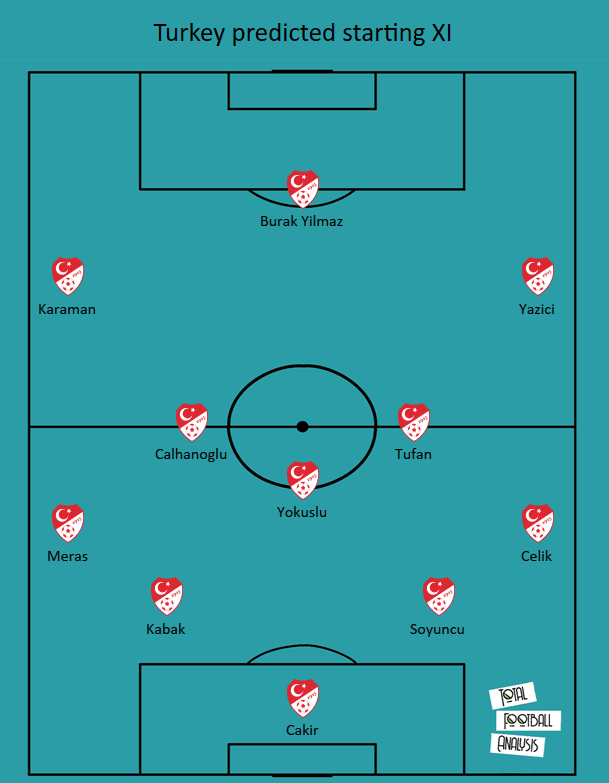
Güneş has a number of interesting and quality options available to him, and a good mix of youth and experience as well, as we can see in the age profile chart too. There have been a couple of surprising non-selections, with the likes of Caner Erkin, Hasan Ali Kaldırım and Cenk Tosun left behind, but all three players have had underwhelming campaigns this season, and it has been refreshing to see a number of young players picked in the preliminary squad. In fact, only three of these players were part of the squad at Euro 2016, which is also a reflection of how quite a few Turkish players have progressed in the intervening years.
In terms of the starting XI, Güneş does seem to have a set of players that he trusts, while we can make our best guesses for the rest of the lineup. Trabzonspor’s Uğurcan Çakır will be Turkey’s number one goalkeeper, with Mert Günok providing experienced backup, and Gökhan Akkan as the third-choice keeper. In defence, Zeki Çelik will start at right-back, fresh off a Ligue 1-winning campaign with Lille, where the 24-year-old played a key role, and he has nailed down his place for the national side as a result as well. Çağlar Söyüncü and Ozan Kabak are expected to be the starting central defensive pair, but Juventus’ Merih Demiral could potentially displace either of these two in the XI. In Erkin’s absence, Umut Meraş is expected to take the left-back slot, with Çelik able to provide cover there as well. The likes of Kaan Ayhan and Mert Müldür will be the backup options on the bench.
Midfield is perhaps the area with the most talent for Turkey, and with Güneş likely to set the team up in a 4-2-3-1 or a 4-3-3, there will be one defensive midfielder flanked by two more creative midfielders in the lineup, one of whom can also play as a number 10 if the 4-2-3-1 is used. Of course, that man is going to be AC Milan stalwart Hakan Çalhanoğlu, who is this side’s lynchpin. The 27-year-old is, on form, one of the best creative midfielders in Europe, capable of setting up teammates as well as scoring himself, and he is also extremely dangerous from set-pieces, being lauded as a free-kick expert for years now. Behind him, we are likely to see Ozan Tufan and Okay Yokuşlu. Tufan has had a decent domestic season for Fenerbahçe, and the 25-year-old will provide energy and intelligence in midfield, helping to progress the ball forward whenever possible. Yokuşlu will be the most defensive of this trio, sitting deep and protecting the defence, and he had a huge impact after arriving on loan at West Bromwich Albion in January. Although he was unable to prevent them from being relegated, his performances drew a lot of admiration from across the league, and he may just be on his way to England in a permanent deal from Celta Vigo in the summer on the back of that six-month spell. Turkey have a number of options in this area of the pitch to rest and rotate this trio, who are likely to be the first-choice options for Güneş throughout the tournament.
In terms of the attacking trio, Fortuna Düsseldorf attacker Kenan Karaman will start on the left, while Lille playmaker Yusuf Yazıcı will play off the right, from where he will drift into central areas to link up with Çalhanoğlu. Yazıcı has had an excellent season in Ligue 1, scoring 14 goals in all competitions, and his creative ability will add a huge threat to Turkey’s attack. Up front, the veteran Burak Yılmaz will captain the side, and the 35-year-old forms part of a Lille triumvirate in this squad. Yılmaz has had a stunning resurgence this season, scoring 18 goals in all competitions to be one of the biggest reasons behind Lille’s title win, and he will look to carry that form into the Euros in what is likely to be his last major tournament for his country. The likes of Enes Ünal and Cengiz Ünder offer exciting alternatives in this area of the pitch as well. Overall, Turkey’s first-choice XI has quite a few quality players, and they should be more than a match for their group-stage opponents at Euro 2020.
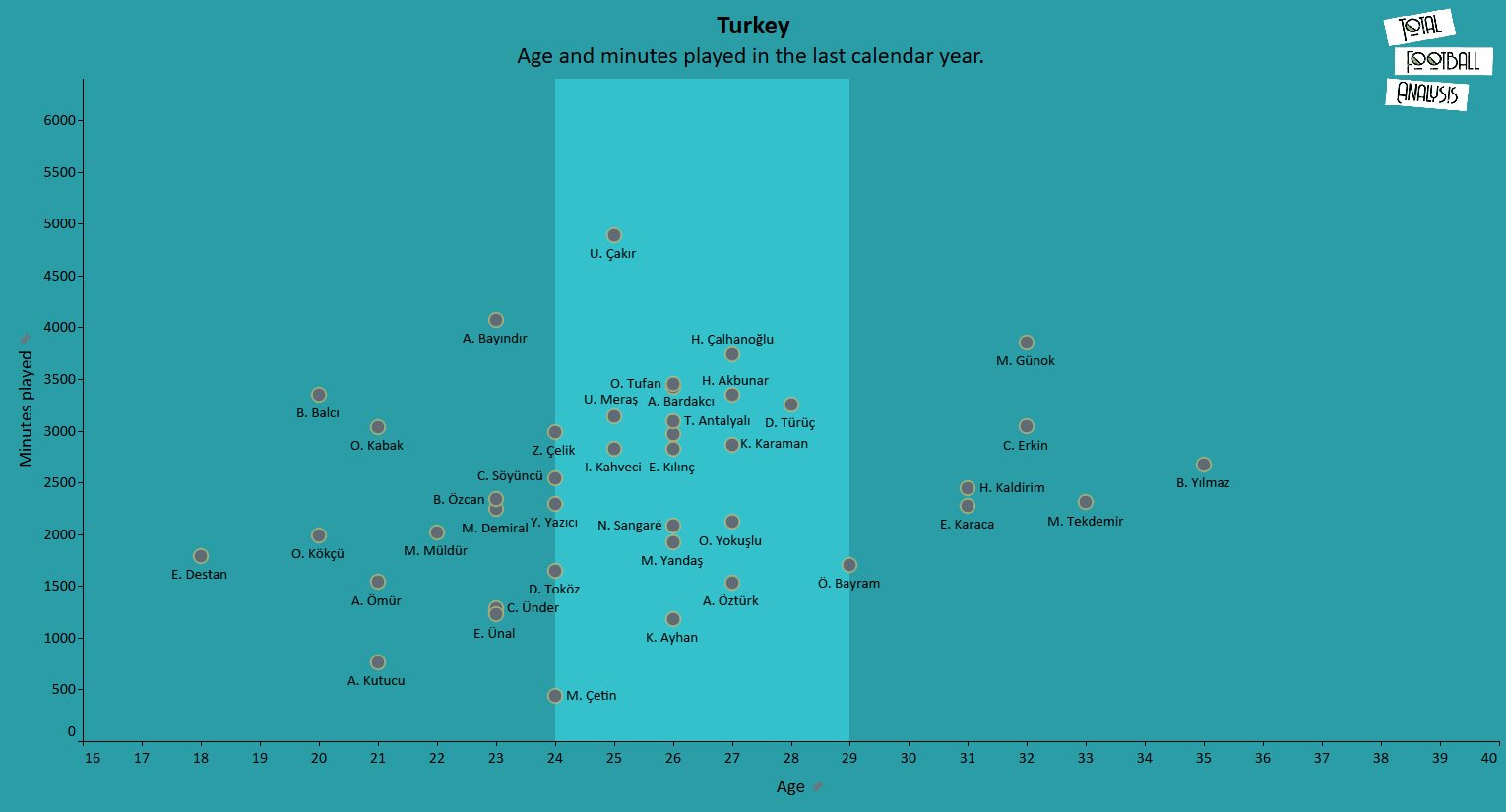
Looking at the age chart, it is clear that the majority of the squad is at their peak years, with only Yılmaz as one of the older players among those who are expected to start at the tournament. There is also a good blend of youth in the side, and a number of those who are expected to play important roles at Euro 2020 have seen a lot of playing time during the season as well, all of which bodes well for a group that should arrive at the tournament with confidence and energy.
ATTACKING PHASE
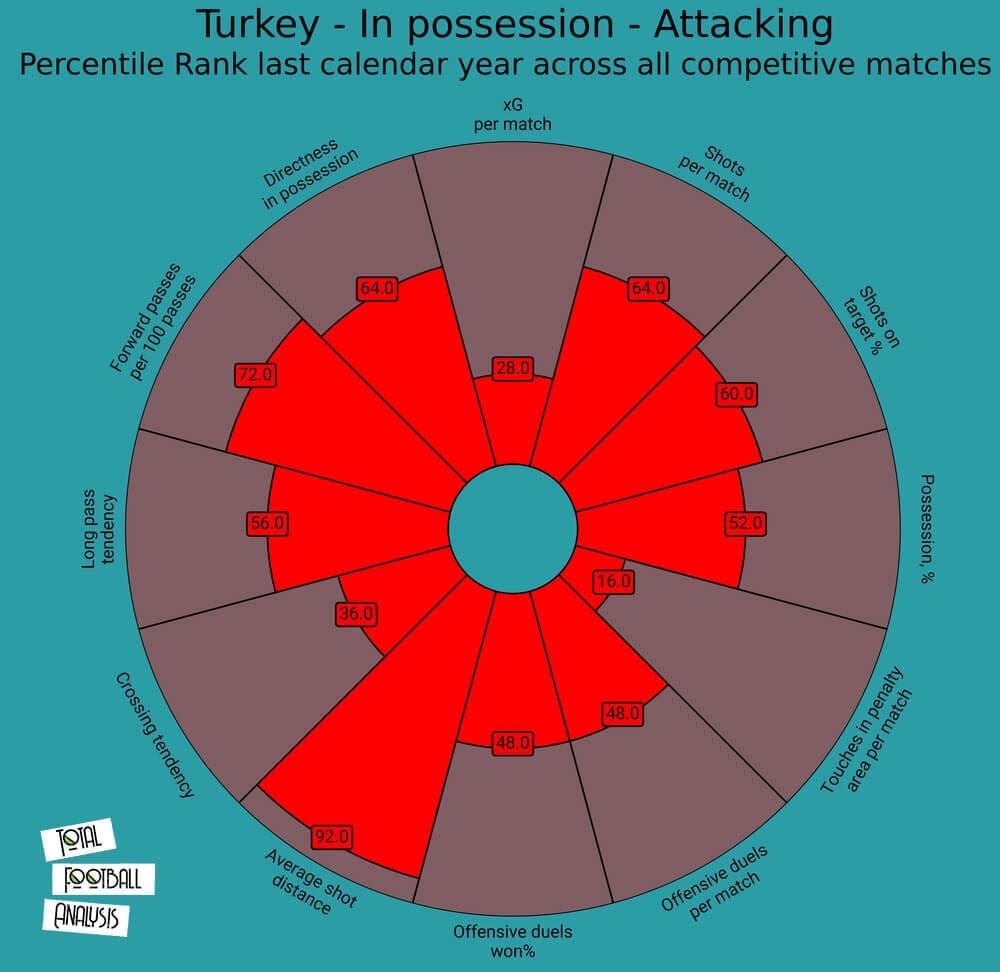
This radar shows a few key attacking metrics and the Turks’ performance on them in relation to the other teams at the tournament, and this will help us understand their playing style and tendencies when in possession. Turkey are around the average for possession %, which indicates that they do not necessarily hold on to the ball too long, looking to pass it forward whenever possible. This is also seen through their ranks for forward passes per 100 passes (72nd percentile) and directness in possession (64th percentile), while they also have an above-average tendency of passing long (56th percentile). While Turkey do fairly well in terms of getting shots on goal (64th percentile for shots and 60th percentile for shots on target %) it is concerning that their rank for xG per match is quite low (28th percentile). Combined with the high rank for average shot distance (92nd percentile), and the low rank for touches in the penalty area (16th percentile) this points towards an alarming tendency to take shots from distance, which will have a much lower chance of going in. While the likes of Yılmaz, Çalhanoğlu and Yazıcı are all extremely capable from distance, this is not a viable attacking strategy, and Güneş must figure out a way to make the side more creative and get them closer to goal if they are to have a better and more consistent chance of scoring goals.
In terms of build-up play, Turkey will often look to go long from their goal-kicks, with Yılmaz moving wide to one flank to be the target man and flick the ball on for runners, or control the ball and lay it off to his teammates, who will try to get close to him in order to win the second ball if necessary. This is an effective way to get the ball into the final third quickly, and takes advantage of Yılmaz’s physical attributes well.
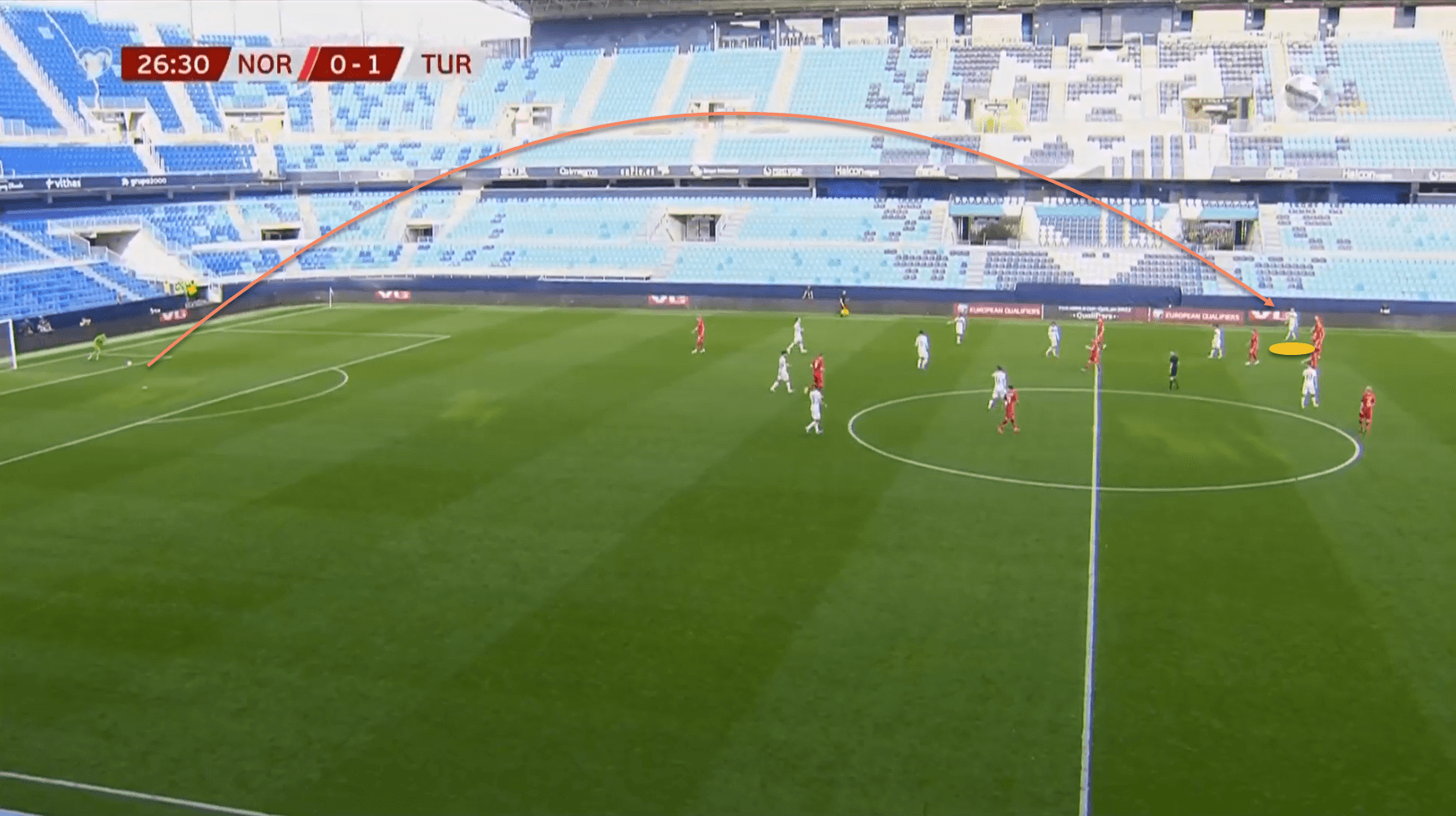
Another feature of Yılmaz’s role in this team is that he does not stay static or offer depth by playing on the shoulder of the defensive line. Rather, the 35-year-old will often drop deep to offer a passing option between the lines, and he is quite capable of then picking out teammates in good positions. This also vacates the central space for the wingers and one of the midfielders to dart into, beyond Yılmaz, and it is often a common sight to see the Turkey captain dropping deep to receive the ball, before spreading it out wide, or laying it off to a teammate centrally who can then play a direct pass to the player making a third-man run centrally.
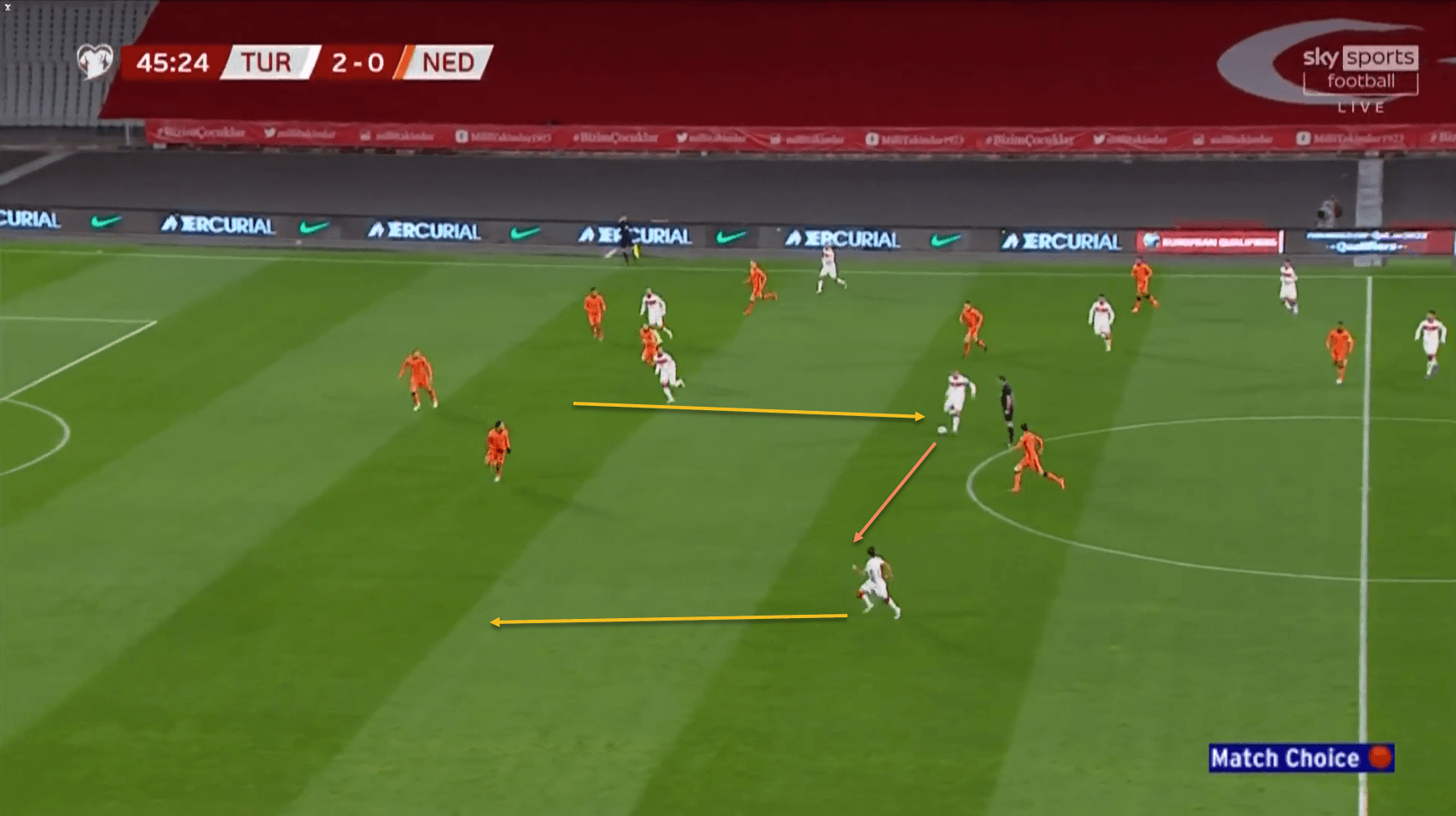
We can see this in this example, where Yılmaz has dropped deep into acres of space, and is able to switch the play out to Meraş on the left.
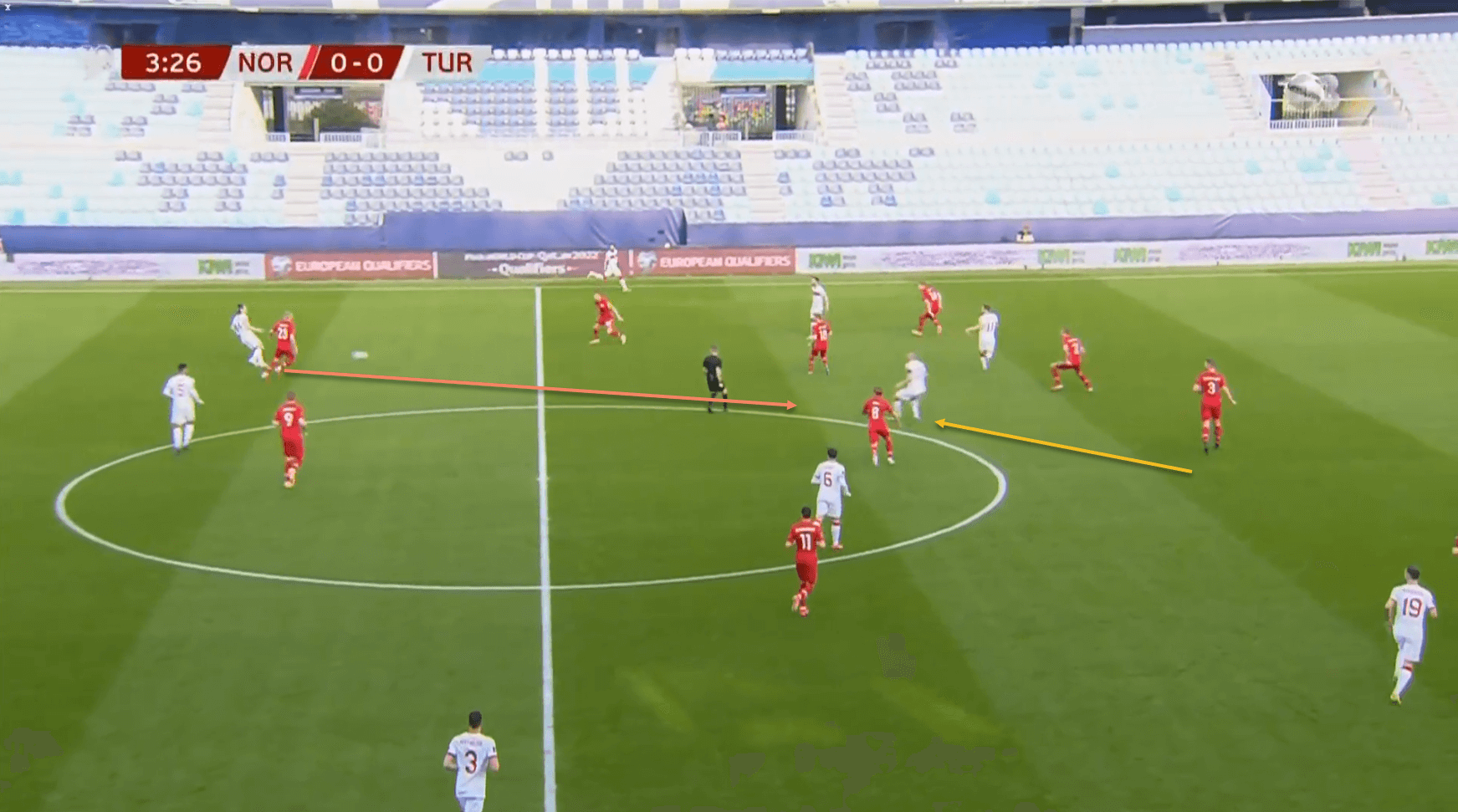
Another example, this time against Norway, where Yılmaz drops deep into space to receive possession from Söyüncü, and lays it off with his first touch to a supporting teammate.
Turkey’s style of play is predicated on quick, direct passing with a lot of runners into space, and Yılmaz plays a big role in facilitating this through his movement and passing, in addition to his obvious goal threat.
DEFENSIVE PHASE
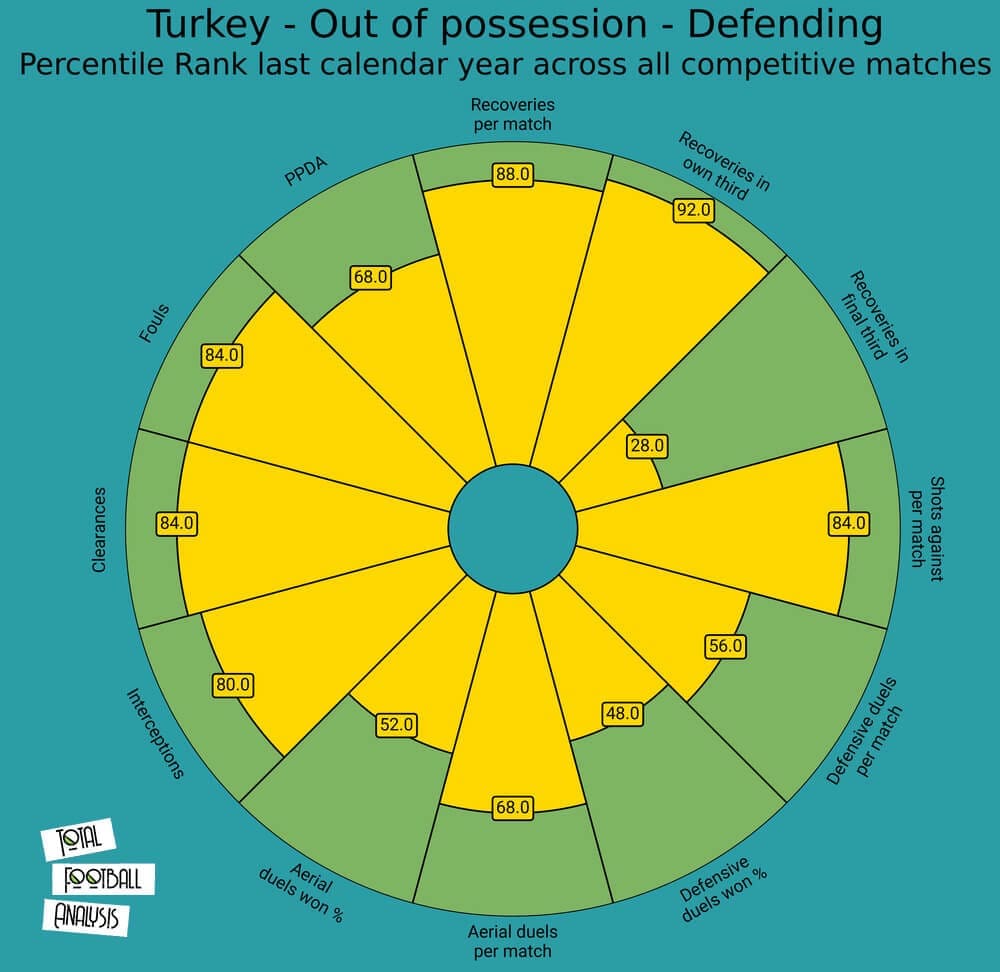
Similar to the previous radar chart, this one looks at a few key defensive metrics and helps us understand Turkey’s defensive style of play. From the start, it is clear that they are an extremely active and physical side, looking to win the ball back in an intense manner, as seen by the ranks for interceptions (80th percentile), fouls (84th percentile) and recoveries (88th percentile). It is also notable that the majority of these recoveries take place in their own third of the pitch (92nd percentile) than the opponent’s third (28th percentile), and this, combined with the ranks for PPDA (68th percentile) tells us that Turkey generally will look to sit back and defend deep, rather than pressing high up the pitch. However, they do face a lot of shots through this approach (84th percentile), and therefore the emphasis will be on ensuring that these shots are from low-quality areas and from distance, rather than from up close in and around the penalty area.
Turkey will look to stay compact centrally wherever possible, forcing the opposition wide, and not looking to press aggressively in the final third.
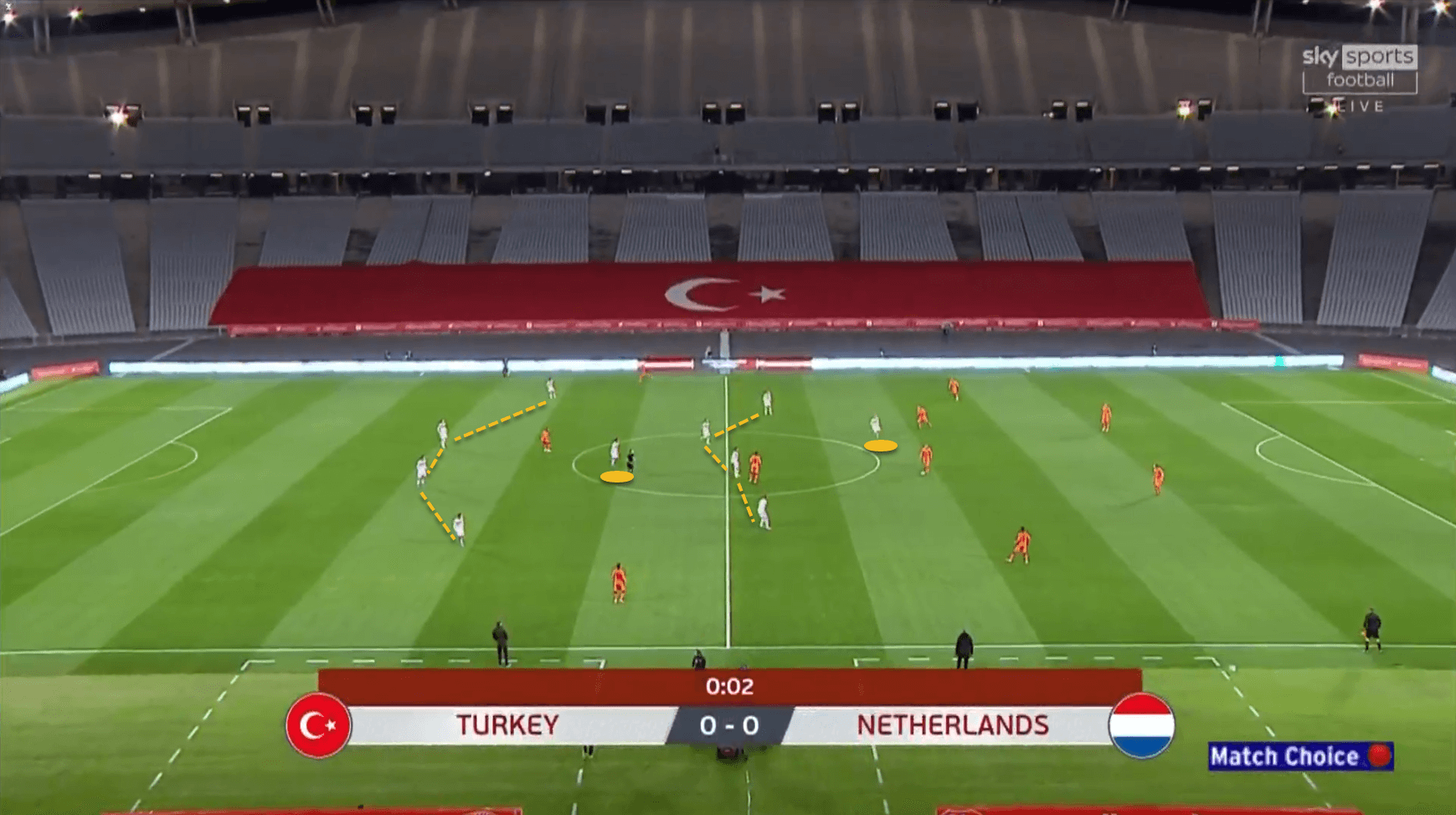
The opening moments of the match against the Netherlands offer a good view of Turkey’s shape off the ball – they will drop into a 4-1-4-1, with the defensive midfielder protecting space between the lines, and the second line of four staying narrow to stop central progression for the opposition.
This emphasis on denying central progression can be seen in the next image as well, where Turkey form two central triangles to force the ball wide.
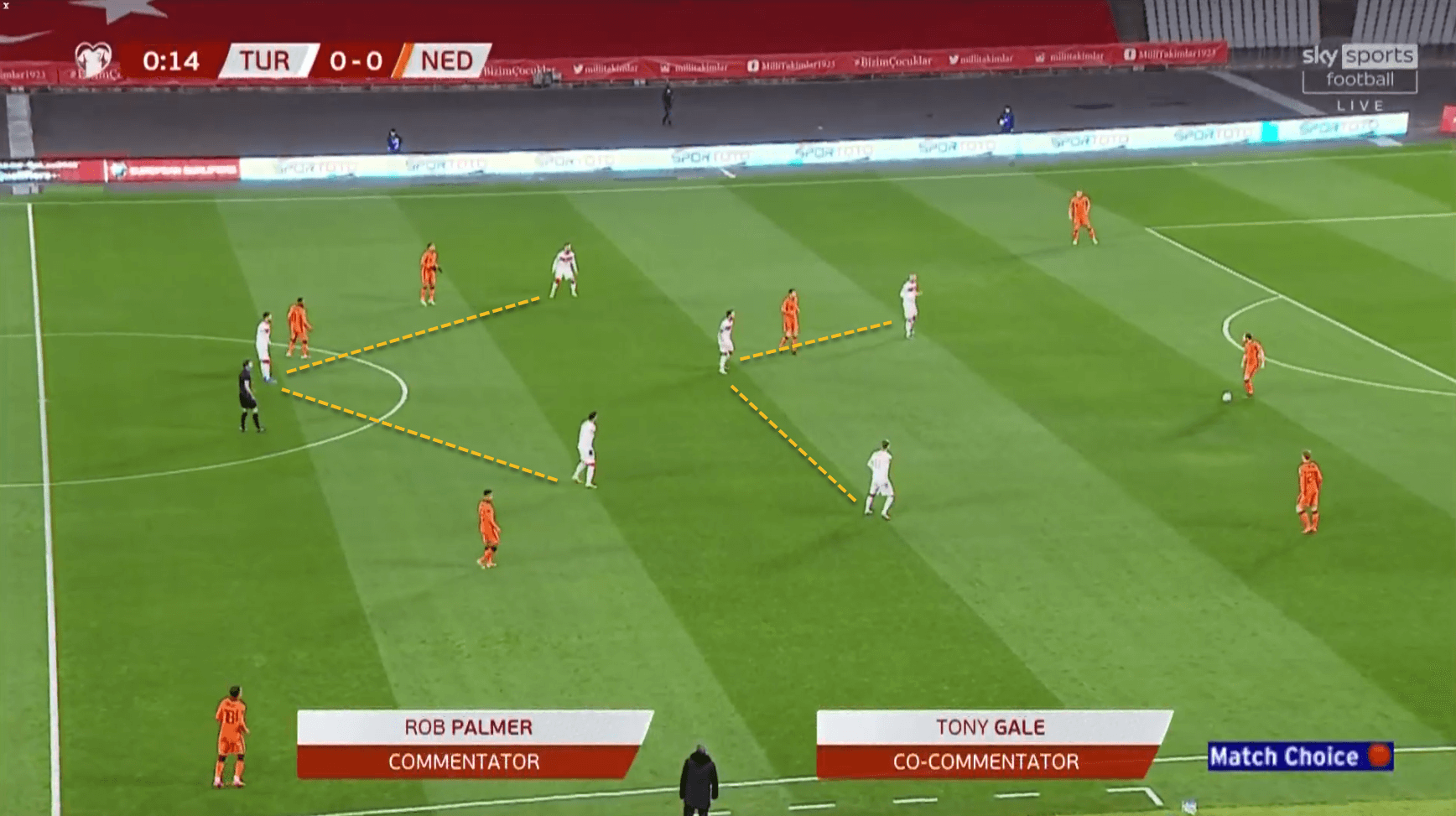
We can see how the Turks have moved slightly up the field, but are not pressing the Netherlands’ centre-backs – instead, they are trying to deny easy passes into the central spaces, with Yılmaz having shifted slightly wider alongside Yazıcı, while Çalhanoğlu stays deeper as the central player of the trio to create that funnel-like shape and force the ball wide. This shape is replicated in the second line, where Yokuşlu is the deepest player
However, Turkey will try to win the back in a more aggressive manner in their middle and defensive thirds, while maintaining this 4-1-4-1 shape to stay compact and narrow.
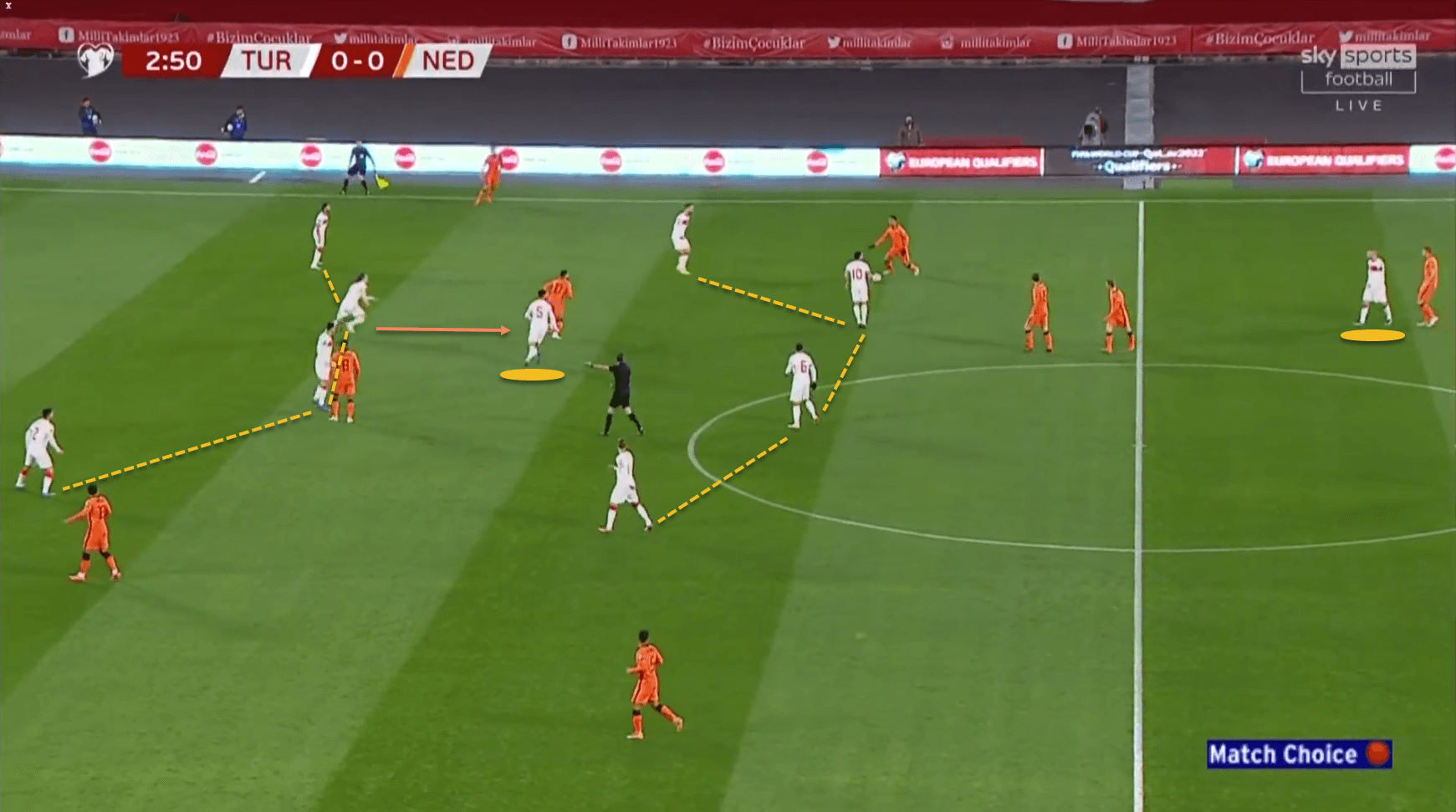
We can see Turkey’s shape here, with Söyüncü looking to aggressively press Memphis as he offers himself as a passing option between the lines.
Turkey’s defensive lines will tend to drop deep onto the edge of their own box during spells of sustained possession for the opposition, with Yılmaz left upfield as the target man for long passes once possession is regained.
TRANSITIONS
We have already mentioned the key role that Yılmaz plays for Turkey’s offensive strategy, and this extends to transitions as well, where his ability to hold up the ball and bring runners into play is vital. Turkey look to counter-attack quickly and with numbers when they regain possession, while attempting to find one of those runners with passes into space from a deeper player.
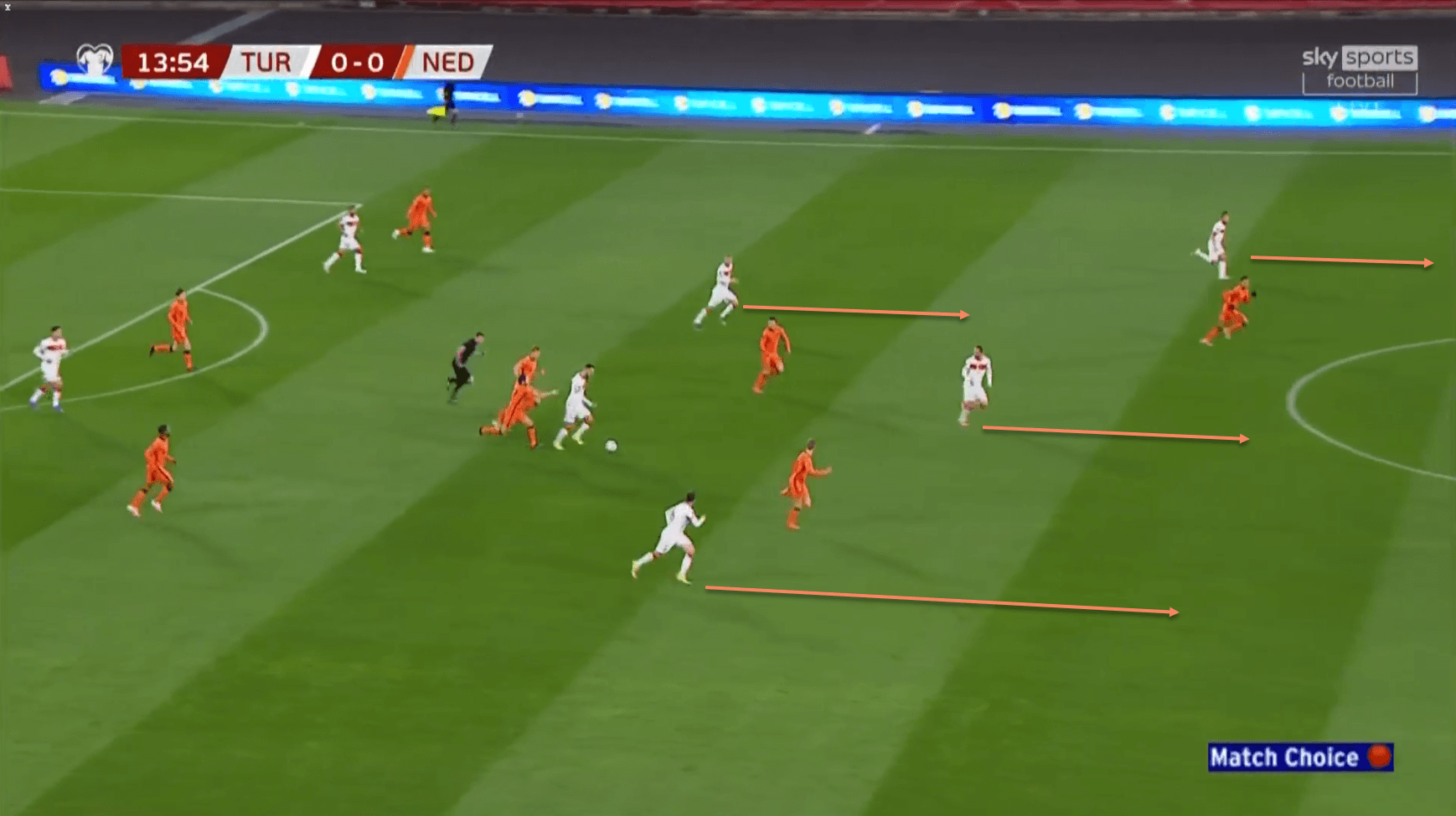
Another facet of their attacking transitions is the emphasis on having late runners into the box from the far side to attack crosses. This is also seen in their general attacking play, where they will sometimes work the ball down one flank to draw the opposition out before quickly switching it to the opposite side, where the full-back or wide player has space to run into.
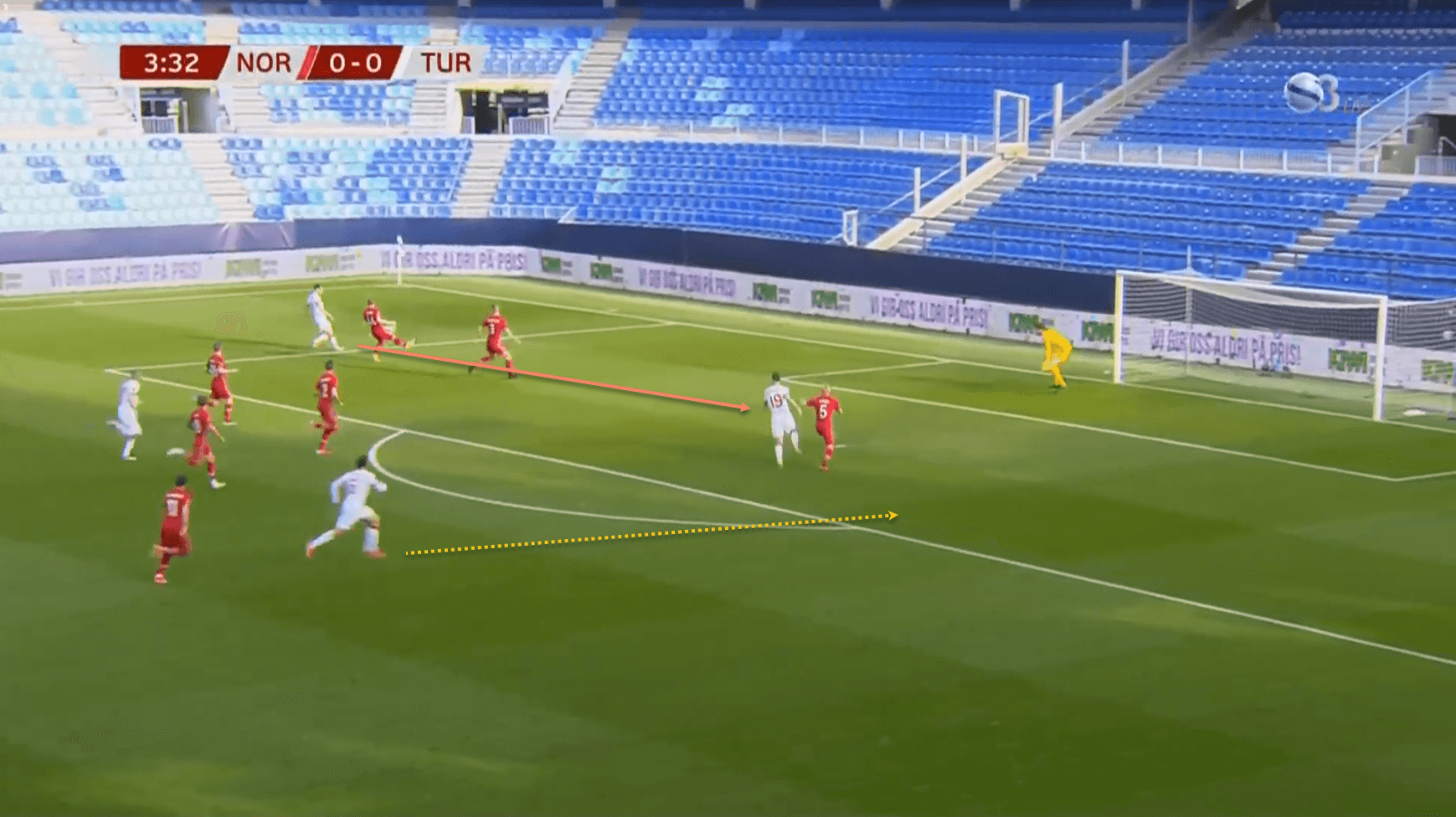
In terms of defensive transition, we have already mentioned how the Turks are unlikely to press high, preferring to drop into a compact shape quickly. They are quite intelligent in doing so, first applying pressure on the man in possession while cutting off easy passing options to slow down counter-attacks, which then buys them the time needed for numbers to get back into shape.
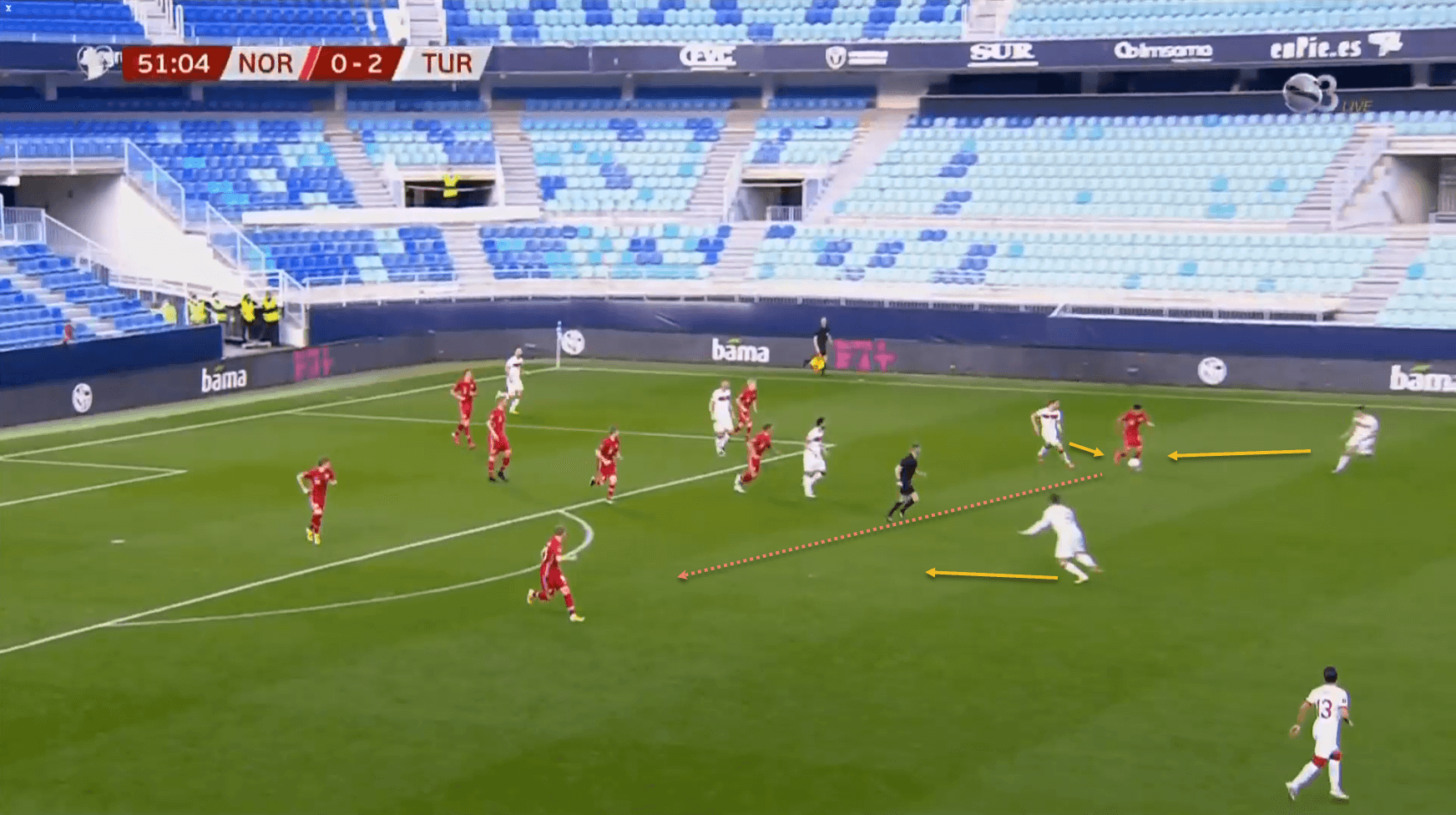
As soon as the ball is lost here, two players converge on the Norway player in possession, while another Turkey player moves across to cut off the easy pass to Martin Ødegaard.
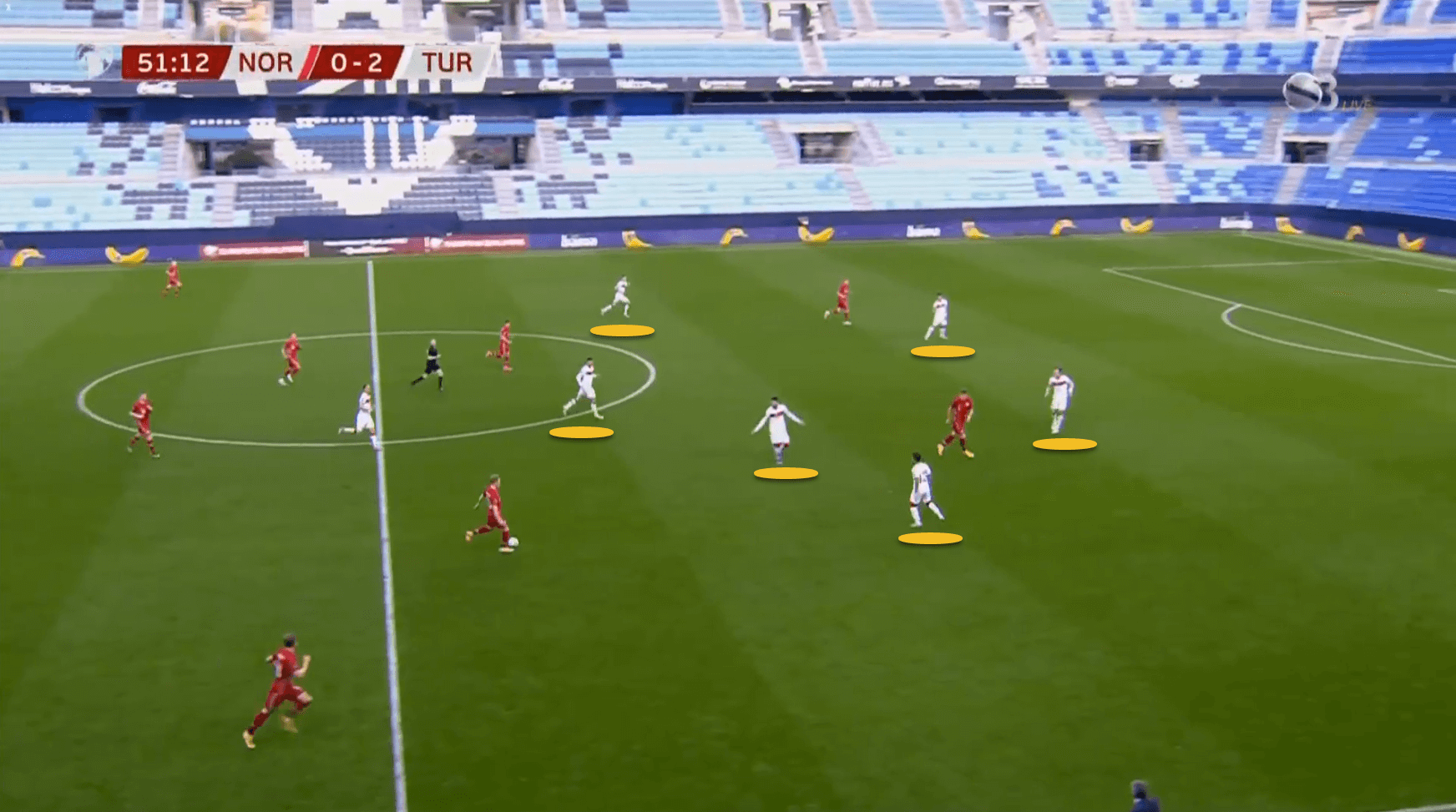
Ødegaard does get on the ball eventually and is able to drive forward, but by then, Turkey have managed to get six players behind the ball and are already blocking central passing lanes, forcing Norway wide.
Of course, this is not a fool-proof strategy, and our earlier metrics showed how Turkey have been susceptible to conceding goals over the last year. However, we believe that this is the best way for them to continue playing in their established style of play, and it is only their execution of this strategy that needs to improve, rather than a change in strategy itself.
FORWARDS
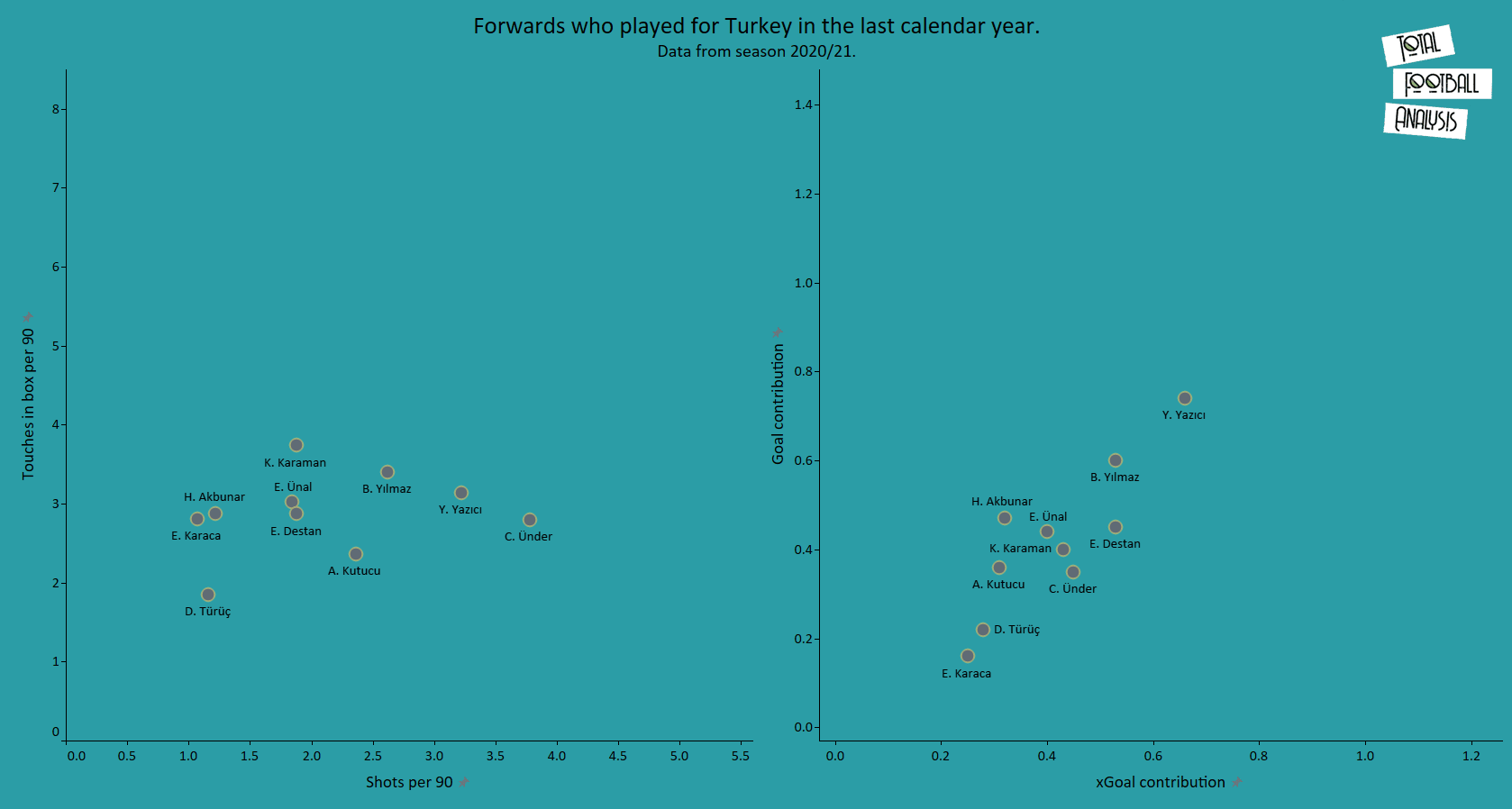
We will now compare the various attacking options at Güneş disposal, looking at all the attackers to have been called up to the Turkey squad over the last calendar year, while focusing on those who are part of the preliminary squad for Euro 2020. The chart on the left looks at touches in the penalty area and shots per 90 for this season, and we can see that Karaman leads the squad for touches in the area. This may be a reflection of the fact that he played as a striker for Düsseldorf this season, while he is likely to be used on the left for Turkey. The likes of Yazıcı, Yılmaz and Ünder have had a decent number of shots per 90 this season, and it is especially encouraging that Ünder has registered such strong numbers despite failing to feature regularly for Leicester City in the Premier League this season.
The second chart considers goal contributions as compared to expected goal contributions, and it is here that the Lille playmaker Yazıcı really stands out. He played a big role in Lille’s Ligue 1 triumph, along with Yılmaz, who also performs well on this chart, and these two players are likely to be Turkey’s biggest offensive threats at this tournament, alongside Çalhanoğlu.
MIDFIELDERS
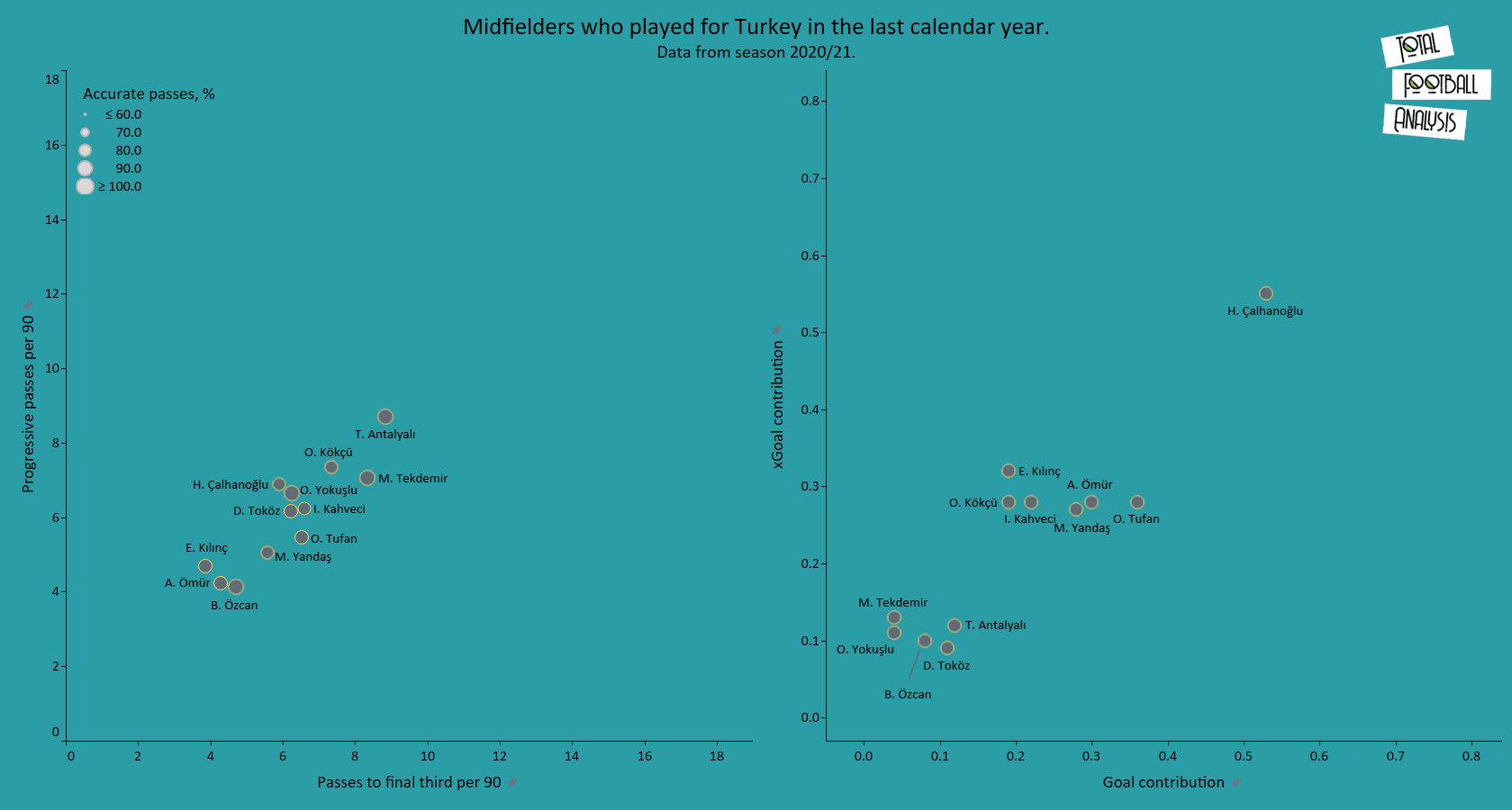
Next, we will look at Turkey’s midfielders. The chart on the right is the same as the one in the previous section, while the one on the left compares these players for passes to the penalty area and progressive passes per 90, with the size of the individual dots indicating their overall pass success rate. Taylan Antalyalı, the Galatasaray midfielder, has been the best performer for both metrics, while also delivering a decent pass success rate. It is notable how Çalhanoğlu, Yokuşlu and Tufan, the three most likely midfield starters at the tournament, all have rather average performances for these two metrics this season, with Çalhanoğlu’s pass success rate being quite low as well. This is a reflection of his role with AC Milan, where he tries a lot of risky passes rather than playing a safer, more conservative pass, and he will have a similar role to play with Turkey as well, especially given their tendency of going direct.
Of course, when it comes to goal threat, Çalhanoğlu is streets ahead of the rest of Turkey’s midfielders. The 27-year-old notched nine goals with a further 14 assists in all competitions for the Rossoneri this season, and this is another indication of how he will be Turkey’s creative hub at this tournament. The rest of Turkey’s midfielders do not fare too well on these stats, which puts even more responsibility on Çalhanoğlu’s shoulders.
DEFENDERS
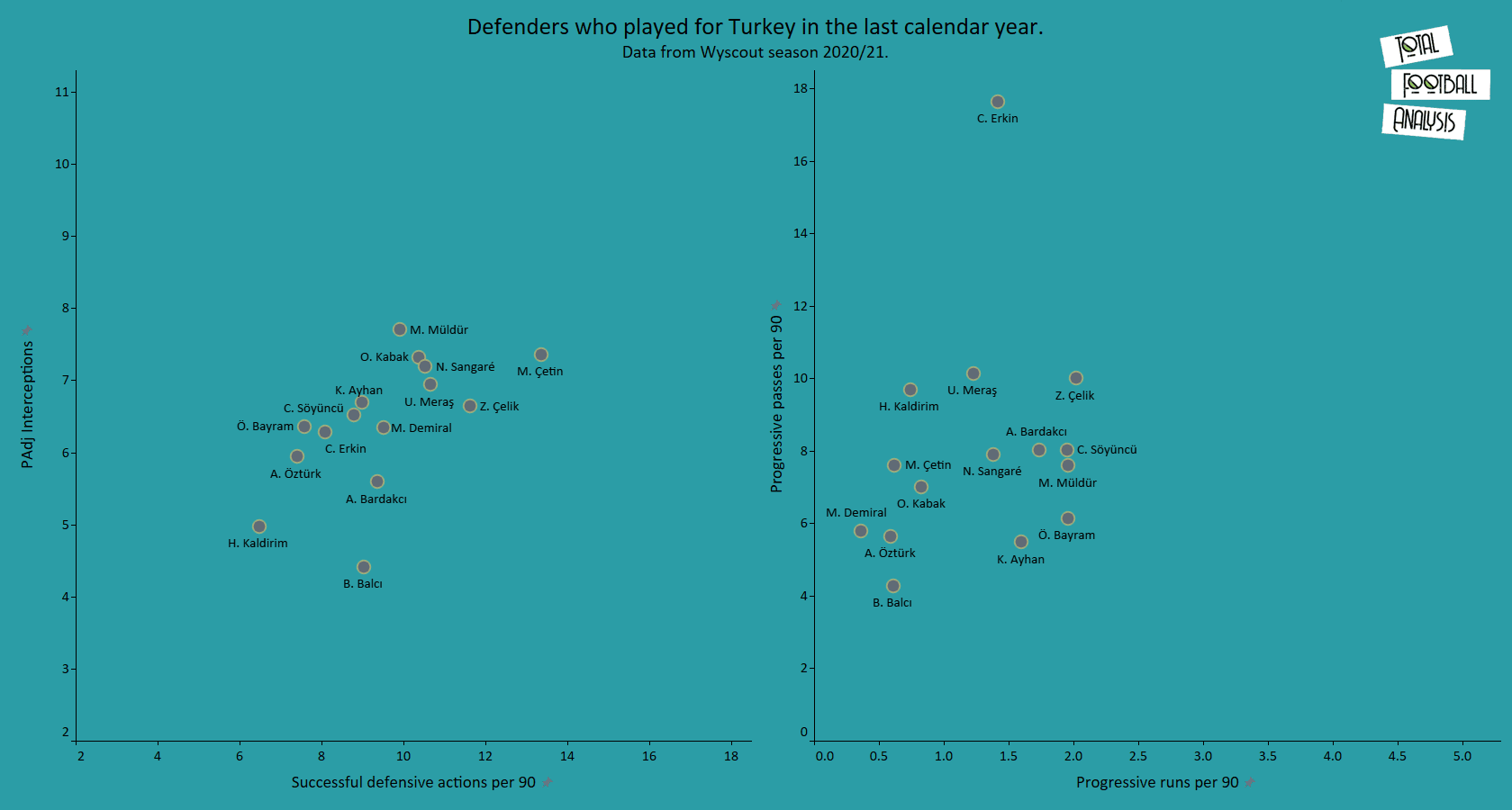
Lastly, we will compare Turkey’s defensive options here. While it is extremely difficult to compare defenders through statistics, given that so much of quality defending cannot be captured by the existing metrics, this is still an important proxy in trying to identify the key personnel in Turkey’s defence. The first chart looks at defensive metrics, while the second chart considers these players’ ability to progress the ball through passes and runs.
Sassuolo’s Mert Müldür is the best performer when it comes to possession-adjusted interceptions, while fellow full-back Zeki Çelik has the most successful defensive actions per 90 of the players in the preliminary squad. Kabak, Ayhan, Demiral and Söyüncü, the four potential centre-back options, are all around the average for these metrics, which is also a reflection of their respective clubs’ style of play.
Despite an underwhelming season for Fenerbahçe, the furore around Erkin’s absence from the squad can perhaps be understood when we look at the second chart. The left-back has nearly double the number of progressive passes per 90 than the next players on the list, which is an indication of his ability to provide a creative threat from deep. This is something that Turkey may come to rue at Euro 2020, but Meraş and Çelik, the two likely starting full-backs, have not done too badly in this regard either. Çelik also has among the most progressive runs of this defensive unit, but overall, the Turkish defence is likely to play a role in their team’s possession through their passing from deep rather than by running with the ball, as this chart suggests.
BEST PERFORMER
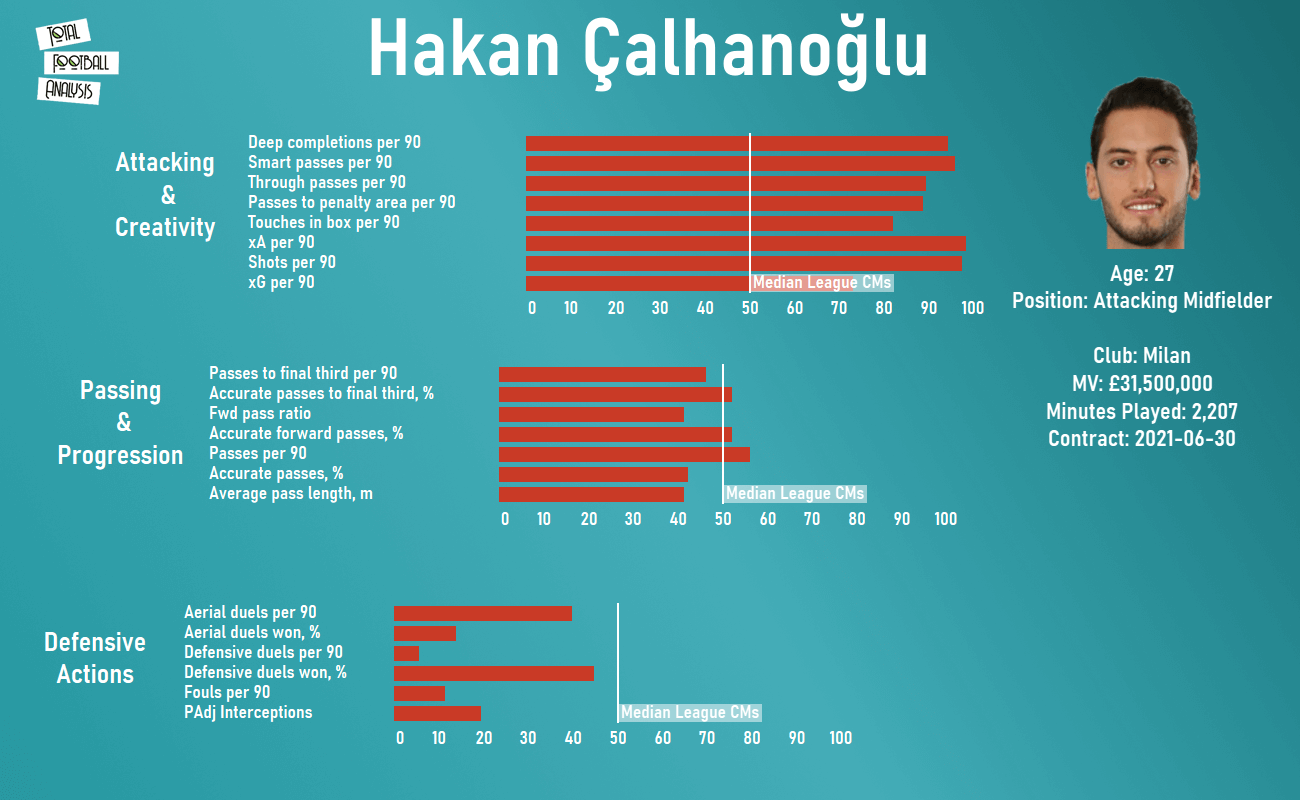
It should come as no surprise that we have picked Çalhanoğlu as the team’s key performer at Euro 2020. The 27-year-old is one of very few Turkish players who are established top-class players in one of the major European leagues, and Çalhanoğlu’s experience will be vital in this regard, along with his undoubted quality.
This profile shows how he has been among the most creative and threatening midfielders in Serie A this season, ranking around and above the 90th percentile for xA per 90, shots per 90, smart passes per 90 and deep completions per 90. He has also ranked well for through passes, passes to the penalty area and touches in the box, all of which show his ability to affect the game from in and around the opposition’s penalty area. When considered together with his passing metrics, we can see that Çalhanoğlu is a pretty direct player – one who does not make too many passes per match, but tries to make an impact with every pass. This is the sort of play that he will have to bring to Turkey as well, as they will need someone to feed the likes of Yılmaz, Yazıcı and Ünder with quick passes out wide and behind the opposition’s defensive line. Çalhanoğlu will also pose a huge threat from set-pieces, both in terms of his delivery from corners and wider free-kicks, as well as the potential to score from more central positions.
The 27-year-old is not expected to play a big role in Turkey’s defensive efforts, but he can be relied on to get back and drop in as part of a solid shape. Overall, Turkey’s fortunes at Euro 2020 will rest a lot on his form, and given that he is out of contract at AC Milan in June as well, there is even more incentive for the playmaker to provide high-quality displays at this tournament as he pursues a lucrative contract in Milan or elsewhere.
PREDICTIONS FOR THE TOURNAMENT
Turkey have been drawn in Group A, alongside Italy, Wales and Switzerland. It is expected that Italy will top the group, leaving the other three to battle it out for second place and a potential third place qualification, and Güneş has admitted as much publicly, in a bid to lower expectations. We have mentioned how this is largely a new squad, with just three players from the previous Euros, and while there are some exciting and in-form players available, the group stage will not be an easy task, with all three teams above Turkey in the FIFA rankings. We do expect Turkey to qualify from this group, either as the second-placed side or as one of the four best third-placed teams. Second place would bring a round-of-16 tie against Russia or Denmark, while qualifying via third place could see them face one of Belgium, Spain or the winners of Group F (Portugal, France or Germany). It is quite clear that finishing second would offer a much easier route to the quarter-finals, where the Netherlands would be their most likely opponents. Having beaten them quite recently in the 2022 World Cup qualifying campaign, Turkey will go into this match with no fear of their opponents at all. Of course, this is a hypothetical scenario, and will need a lot of pieces to fall into place, but we predict that Turkey will manage to make it to the quarter-finals after finishing second in their group, and if a potential match against the Dutch does materialise, anything could happen.

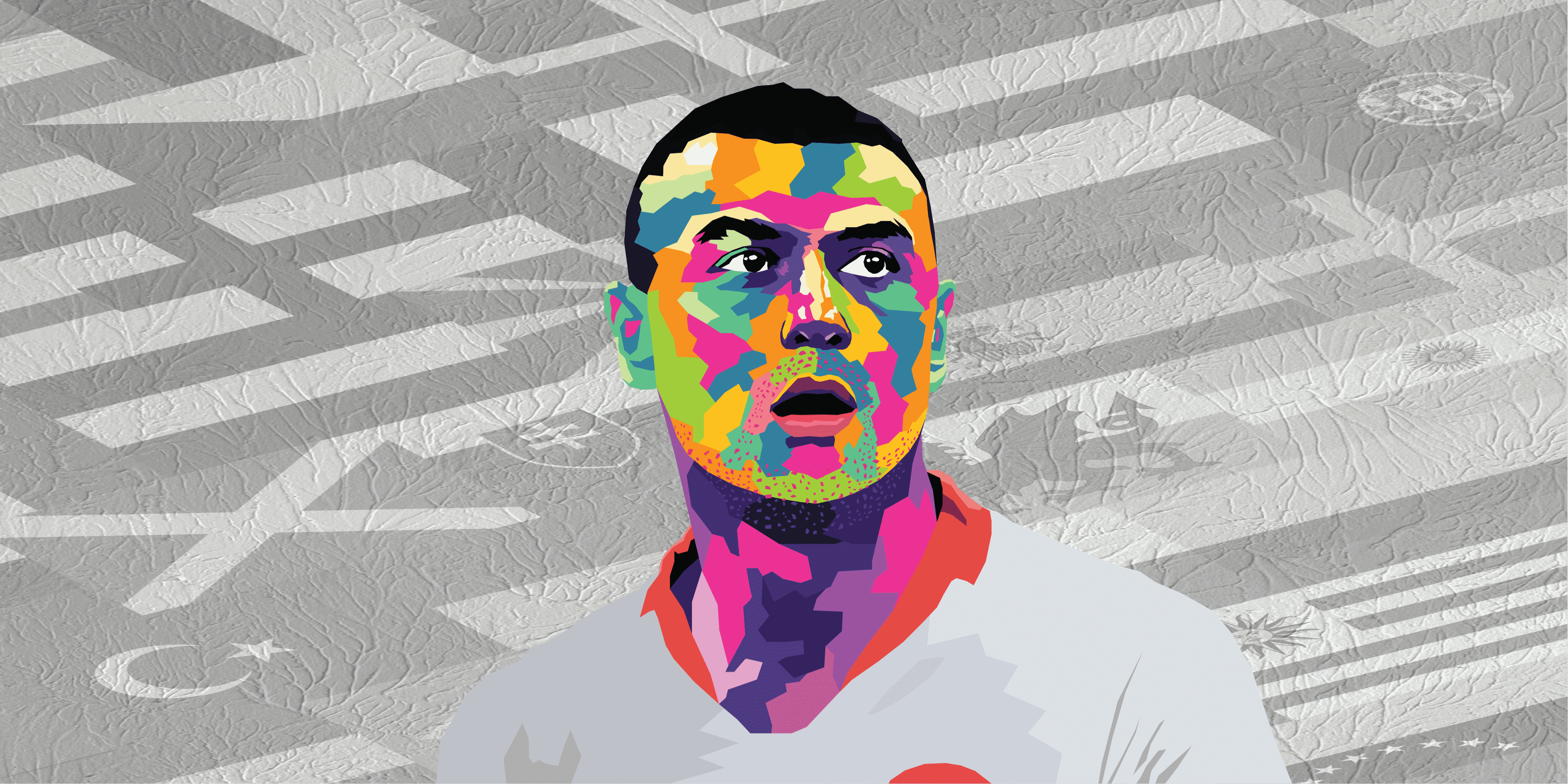



Comments